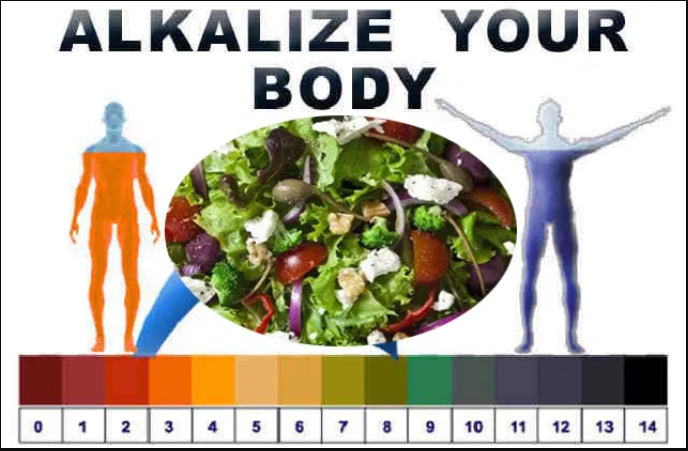Body ALKALINITY - What does it tell me?
Posted by Just Fitter on
Alkalinity means that something has a pH higher than 7. The term pH stands for “potential of hydrogen” which is the measure of hydrogen ions in a solution. A pH scale measures how acidic or alkaline a substance is and ranges from 0 to 14. Seven is neutral. Below 7 becomes increasingly acidic while above 7 is increasingly alkaline.
In the human body, the pH level varies for many reasons. For example, the skin and vagina should be slightly acidic–to help keep unfriendly bacteria away. Saliva is more alkaline, while urine is normally more acidic, especially in the morning. By far the most important measurement is the blood. So, what’s a normal blood pH? The blood has a normal pH range of 7.35 to 7.45. This means that it is naturally slightly alkaline or basic. Because the body always wants to maintain that optimal 7.35 to 7.45 pH, it always finds a way to deal with all of the excess acid that the body produces depending on our diet. Luckily, it is pretty good at its job. The bad news is that it can only handle so much before there are serious problems so it is important that we balance our body’s pH level.
Maintaining the pH Balance
The lungs and kidneys play a key role in this process. In our body, the lungs control the pH balance by releasing carbon dioxide. Carbon dioxide is a slightly acidic compound. It’s also a waste product produced by the cells in our body as they use oxygen. The cells release it into the blood, and are taken to our lungs. When we exhale, we’re expelling that carbon dioxide, a process that also helps regulate the body’s pH balance by reducing acidity. The amount of carbon dioxide we exhale is a function of how deeply we inhale or exhale. The brain constantly monitors this in order to maintain the proper pH balance in the body.
The kidneys help the lungs maintain acid-base balance by excreting acids or bases into the blood. The kidneys’ effect on acidity works much more slowly than that of the lungs.
What Causes pH Imbalance?
There are many reasons why the pH level shifts towards a more acidic state. Among them is an increase in acid that overwhelms the body’s acid-base, which causes the blood to turn acidic and the kidneys to start excreting more minerals out of the body through urine. High levels of acidity from our diet forces the body to remove minerals. This results in the cells lacking enough minerals to properly dispose of the waste from the body. Vitamin absorption gets compromised by the loss of minerals. Pathogens start accumulating in the body and this can suppress the immune system.
pH Balance Disorders
A blood pH imbalance can lead to two conditions: acidosis and alkalosis.
Acidosis refers to having blood that is too acidic, or a blood pH of less than 7.35. Alkalosis refers to having blood that is too basic, or a blood pH of higher than 7.45.
There are different types of acidosis and alkalosis based on the underlying cause.
When acidosis or alkalosis is caused by a lung disorder or issue with exhalation, it’s referred to as “respiratory.” When acidosis or alkalosis is caused by a problem with the functioning of the kidneys, it’s referred to as “metabolic.”
How to restore the pH Balance in The Body?
The most effective way to support a balanced pH is to have loads of nutrient-dense, alkalizing plant foods. Other factors that also come into force are stress, sleep, gut health and medications which decide how hard the body has to work to maintain its appropriate pH level.
Alkaline diets, which are also called alkaline ash diets, help to restore proper pH levels and has been linked to improving health – like protection from heart disease, prevention of calcium accumulation in urine, reduced inflammation, lowered diabetes risk, prevention of kidney stones, kidney disease, reduction in muscle spasms, maintaining stronger bones, protection against vitamin D deficiency, and reduced lower back pain.
Below are Steps that help maintain the pH balance:
1. Reduce Intake of Acidic Foods
It is necessary that you eat a diet that’s lower in acidic foods. Eliminate or limit the acidic foods from diet such as processed meats, added sugar, foods high in sodium, processed cereal grains, fried foods, refined grains, alcohol and caffeine.
2. Consume an Alkaline Diet
Consume more alkaline-forming foods. A pH balanced diet includes lots of green plants and other alkalizing foods. These include leafy green vegetables like kale, beet greens, spinach, alfalfa grass, wheat grass, etc. Non-starchy vegetables like mushrooms, tomatoes, cucumber, radishes, broccoli, avocado, garlic, ginger, green beans, cabbage, celery, asparagus, and zucchini can also be consumed.
Superfoods like sea vegetables, bone broth, spirulina, healthy fats like extra virgin olive oil, eggs, nuts, organic grass-fed butter, plant protein, fruits like citrus fruits, dates and raisins are all very alkalizing. Apple cider vinegar can also help restore pH balance.
3. Drink Alkaline Water
Alkaline water has a pH between 9 to 11. Adding baking soda to the water also boosts alkalinity. On the other hand, distilled water has a neutral pH of 7. Distilled water and filtered water are better options than tap water or purified bottled water.
Drink lemon water daily: Lemon water also enhances liver function and provides the antioxidant vitamin C, which fights cell damage by free radicals. Also, drink adequate amounts of water to help restore pH balance.
4. Manage your stress
Manage stress by taking time out to do things that you enjoy and promote a positive attitude. While diet has the biggest impact on our pH level, reducing stress also encourages alkalinity. For example, light stretching, yoga, meditation and deep-breathing exercises can all help.
Testing Your pH
You may want to start testing your pH to make sure you’re on track. Though not really necessary, it always helps to be conscious. You can check for test strips near you or order online. They are readily available, very convenient and practical.
How does a pH test strip work? A pH test strip is a strip of litmus paper with which you can measure the pH value of a liquid. The substance in the paper causes the paper to show a different color at different acidities. The official pH scale is from 0 to 6, where 0 is very acidic and 6 very alkaline.
In order to gain full insight into the pH of your body fluids, it is recommended to test both – urine and saliva. Below are also some helpful tips should you decide to start testing.
How to use pH test strips
How to test your urine:
- To test, place the pH test strip in the urine stream (mid-stream) until both pads on the test strip are sufficiently covered in liquid, then remove.
- Shake off any excess fluid and wait 15 seconds;
- Compare color change to color chart. Discard the used pH test strip.
Try and complete the color matching as soon as possible as the colors are not stable and can change further.
For urine, a slightly higher pH level of 7+ is good, but remember that due to the kidney’s processing of toxins, the first urine can be more acidic.
How to test your saliva:
Wait 2 hours after eating, drinking or brushing your teeth. Try to fill your mouth with saliva and then swallow. This helps remove any acidic bacteria that might be lurking. Do not rinse your mouth with anything else as you will simply record the pH of the water/liquid you have just used.
- Put some saliva on a spoon and then test the pH by dipping the strip into it. Non-bubble saliva works best.
- Make sure both pads on the test strip are sufficiently covered in liquid, remove and then wait 15 seconds (or the time indicated on the pack instructions).
- Match the color reading against the indicator chart in the pH test strips' packaging. Discard the used pH test strip.
How to Read pH test Strips
Compare the color of the strip to the chart provided. Your pH strips should come with a pH color chart. When your test strip has finished reacting, hold it up to the chart and compare the color of the strip to the color chart. When you find the number associated with the color on the strip, you’ll have your pH reading.

pH Strip Colors. What do they mean?
Below are useful information to better understand the test results:

10 Parameter Urinalysis Strip Test
These strips provide 10 tests in one and enables you to monitor your health from the convenience of your home without going to a doctor for a Urinalysis test every time you think you have some issue since they can be very expensive and time consuming. Having these tests assists you in diagnosis and monitoring many metabolic or systemic diseases that can go unnoticed because they have not produced striking signs or symptoms yet.

10 Parameter Urinalysis Test Color Chart
Conclusion:
Balanced body pH plays a role in overall health as well as bone health. Therefore, it is always important to sustain a pH balance in the body. Restoring the pH level in our body includes reducing intake of acidic food, consuming an alkaline diet, drinking alkaline water and managing stress. We can always check our body’s pH thru test strips. Though these are not really necessary, they help you monitor your health at the convenience of your homes.
References:
- https://kriscarr.com/blog/ph-balance-alkaline-foods/
- https://www.healthline.com/health/ph-of-blood#blood-p-h
- https://medium.com/@daniel_riley/acidity-and-alkalinity-in-the-body-what-you-should-know-195742511047
- https://www.healthline.com/health/ph-imbalance#role-of-lungs-and-kidneys
- https://www.healthline.com/health/ph-imbalance#disorders
- https://careercore.in/ph-balance-body.html
- https://www.simplexhealth.co.uk/how-to-test-your-ph-levels-saliva-urine/









